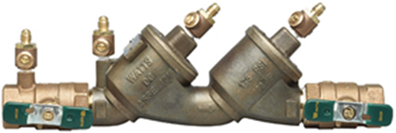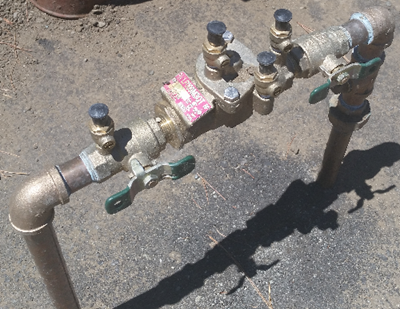SECTION 1. PUBLIC WATER SYSTEM CONTACTS.
NOTE: A person may be assigned multiple contact types. For example, the owner may also be both the Administrative Contact and Financial Contact.
SECTION 2. POPULATION SERVED.
SECTION 4. GROUNDWATER (GW) AND SURFACE WATER (SW) SOURCES.
SECTION 6. WATER RATES AND DELIVERIES.
1101.1.
(h) It is further the intent of the Legislature that retail water suppliers are encouraged to provide incentives, financing mechanisms, and funding to assist property owners with these [plumbing fixture] retrofit obligations.
1101.8.
A city, county, or city and county, or a retail water supplier may do either of the following:
(a) Enact local ordinances or establish policies that promote compliance with this article.
(b) Enact local ordinances or establish policies that will result in a greater amount of water savings than those provided for in this article.
SECTION 8. CROSS-CONNECTION CONTROL.
 |
 |
| Fig. 1 - a double check valve assembly | Fig. 2 - a reduced pressure principle backflow prevention assembly |
SECTION 9. CONSUMER CONFIDENCE REPORT.
SECTION 10. OPERATOR CERTIFICATION.
This shows the classification of your treatment facility with the highest classification (T1, T2, T3, T4, or T5). However, you may see the following instead:
- Treatment or Distribution Operator – your treatment facility or facilities may be operated by either a certified treatment or distribution operator
- Classification is Unavailable – the classification of your treatment facility or facilities has not been entered into the Division’s SDWIS database
- No facilities subject to the Certified Treatment Plant Operator requirements – either you do not have any treatment facilities or these treatment facilities are not subject to the certified treatment plant operator requirements.
If you believe that your highest treatment facility classification is in error, please notify your local regulatory agency immediately.
This shows the classification of your distribution system (D1, D2, D3, D4, or D5). However, you may see the following instead:
- Distribution Operator Not Required – your water system is a transient non-community water system and as such is not subject to the certified distribution system operator requirements
- Classification is Unavailable – the classification of your distribution system has not been entered into the Division’s SDWIS database
If you believe that your highest treatment facility classification is in error, please notify your local regulatory agency immediately.
- If you do not have any certified operators to report, put “NONE” in each column of the first row.
Name Grade of
OperatorChief or Shift1 (C, S or X) Operator
NumberExpiration Date NONE NONE NONE NONE NONE - - - - - - Use the following format and rules to complete the State certified Water Treatment Plant Operators table:
1Use “C” for Chief Operator and “S” for Shift Operator. If neither, put an "X". Do not leave blank.Treatment Operator Name Grade of
Treatment OperatorChief or Shift Treatment Operator
NumberTreatment Certification Expiration Date First name Last name 1, 2, 3, 4, or 5 only. C, S or X only (lowercase ok); do not leave blank. 4 or 5 digits MM/DD/YYYY - - - - - - Use the following format and rules to complete the State certified Water Distribution System Operators table:
1Use “C” for Chief Operator and “S” for Shift Operator. If neither, put an "X". Do not leave blank.Distribution Operator Name Grade of Distribution
OperatorChief or Shift1 Distribution Operator
NumberDistribution Certificate Expiration Date First name Last name 1, 2, 3, 4, or 5 only. C, S or X only (lowercase ok); do not leave blank. 4 or 5 digits MM/DD/YYYY - - - - -
SECTION 13. RECYCLED WATER USE.
- To serve plumbing outlets (excluding fire suppression systems) within a building, or
- Outdoor landscape irrigation at individual residences.
SECTION 14. SYSTEM OPERATION – TREATMENT.
- All suppliers shall have a sanitary survey of their watershed(s) completed at least every five years. The first survey shall be completed by January 1, 1996.
- A report of the survey shall be submitted to the Department not later than 60 days following completion of the survey.
- The survey and report shall include physical and hydrogeological description of the watershed, a summary of source water quality monitoring data, a description of activities and sources of contamination, a description of any significant changes that have occurred since the last survey which could affect the quality of the source water, a description of watershed control and management practices, an evaluation of the system's ability to meet requirements of this chapter, and recommendations for corrective actions.
SECTION 15. SYSTEM OPERATION – DISTRIBUTION.
https://leginfo.legislature.ca.gov/faces/billNavClient.xhtml?bill_id=201520160SB555
SECTION 17. WATER CONSERVATION AND DROUGHT PREPAREDNESS.
http://leginfo.legislature.ca.gov/faces/billNavClient.xhtml?bill_id=201520160SB814
SB 814 refers to “Urban retail water supplier” as meaning CWC Section 10608.12 (p) “Urban retail water supplier” means a water supplier, either publicly or privately owned, that directly provides potable municipal water to more than 3,000 end users or that supplies more than 3,000 acre-feet of potable water annually at retail for municipal purposes.